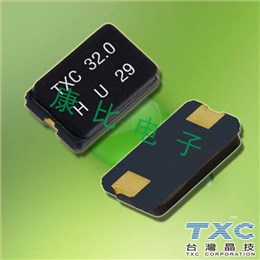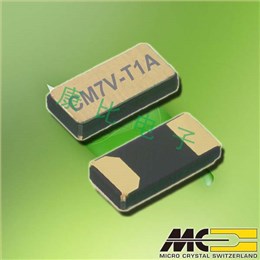Crystek低抖動(dòng)有源晶體振蕩器,全球頂尖供應(yīng)商之一的Crystek公司,也是一家高性能技術(shù)領(lǐng)域的全球領(lǐng)導(dǎo)者無(wú)線電頻率(radio frequency)微波和頻率控制工業(yè),Crystek Corporation一直提供頻率產(chǎn)品,包括石英晶體、XOs(時(shí)鐘石英晶體振蕩器)、TCXOs(溫度補(bǔ)償晶體振蕩器)、VCO(壓控振蕩器)和VCXOs(壓控晶體振蕩器)等元器件,Crystek Corporation的廣泛產(chǎn)品包括各種終端市場(chǎng),包括無(wú)線、微波無(wú)線電、電信、工業(yè)、企業(yè)、航空航天和政府部門。

許多工程師在設(shè)計(jì)振蕩器電路時(shí),并沒(méi)有在石英晶體上花太多心思。對(duì)他們來(lái)說(shuō),這是一個(gè)標(biāo)準(zhǔn)的功能,無(wú)論如何都會(huì)起作用。其實(shí)沒(méi)那么簡(jiǎn)單。
振蕩器電路決定著應(yīng)用的心跳,需要石英晶體和其它元件之間的仔細(xì)匹配。否則,所產(chǎn)生頻率的準(zhǔn)確性會(huì)受到影響,應(yīng)用甚至可能在現(xiàn)場(chǎng)失敗。
我們Crystek希望讓我們的客戶免受此類問(wèn)題的困擾。因此,我們對(duì)客戶的振蕩器電路進(jìn)行詳細(xì)分析,旨在實(shí)現(xiàn)晶體和電路的最佳匹配。在這些所謂的“OSF試驗(yàn)”過(guò)程中檢查了以下三個(gè)參數(shù):
1)頻率精度
2)振蕩安全系數(shù)(OSF)
3)驅(qū)動(dòng)水平
頻率準(zhǔn)確度
振蕩器電路的主要任務(wù)是在整個(gè)應(yīng)用周期和所有環(huán)境條件下產(chǎn)生穩(wěn)定而精確的頻率。為了使總負(fù)載電容(CL)必須盡可能接近額定負(fù)載電容(額定CL)或理想地與之匹配。
因此,電路分析的第一步是確定總負(fù)載電容(CL)石英晶體在其兩端“看到”的。由于與電路的任何直接接觸都會(huì)使測(cè)量結(jié)果失真,因此測(cè)量是在不接觸的情況下進(jìn)行的,使用近場(chǎng)探頭放置在電路上方一小段距離處。然后將晶體從電路中焊接出來(lái),用晶體網(wǎng)絡(luò)分析儀在標(biāo)稱溫度下測(cè)量L.
總C的偏差越大L從名義上的CL晶體的頻率偏差越大。然而,通過(guò)檢查分析儀中的晶體,可以確定需要哪些校正來(lái)提高電路的頻率精度。
振蕩安全系數(shù)(OSF)
在第二步中,檢查OSC振蕩器電路的振蕩安全性。該術(shù)語(yǔ)描述了電路在所有可能的環(huán)境條件下快速可靠啟動(dòng)的能力。因此,分析的重點(diǎn)是電路中的電阻。
如圖1所示,電路中內(nèi)置了一個(gè)新的附加電阻(R Pot ),與石英串聯(lián)。然后逐步增加R電位計(jì)的電阻,直到振蕩停止。這種方法模擬“最差情況下的石英”,并揭示特定振蕩器電路中石英的最大容許阻抗。
圖1:典型振蕩電路(Pierce配置),帶有一個(gè)額外的電阻來(lái)計(jì)算OSF
以這種方式確定的最大阻抗與晶體的ESR,max之比最終得出振蕩安全系數(shù)(OSF)。
對(duì)于MHz晶體(AT切割)對(duì)于大多數(shù)標(biāo)準(zhǔn)應(yīng)用,大于5的OSF被認(rèn)為是足夠的。對(duì)于與安全相關(guān)的應(yīng)用,例如汽車行業(yè)或醫(yī)療技術(shù),通常要求OSF大于10。
對(duì)于KHz晶振,OSF值在3到5之間就已經(jīng)被評(píng)為良好,大于5的則被評(píng)為非常好,這是因?yàn)檫@些電路的設(shè)計(jì)功耗非常低。
驅(qū)動(dòng)電平
為了防止石英過(guò)載,需要確定是哪種功率作用在石英上。為此,第一步是使用高頻電流鉗測(cè)量流經(jīng)石英的電流強(qiáng)度(圖2)。從這個(gè)測(cè)量結(jié)果和已經(jīng)確定的電路參數(shù)計(jì)算石英的“驅(qū)動(dòng)電平”。驅(qū)動(dòng)電平不得超過(guò)石英數(shù)據(jù)表中規(guī)定的最大值。Crystek低抖動(dòng)有源晶體振蕩器
圖2:為了計(jì)算驅(qū)動(dòng)水平,測(cè)量流過(guò)石英晶體的電流。
超過(guò)最大驅(qū)動(dòng)電平可能會(huì)導(dǎo)致頻率偏差,或者在最糟糕的情況下,甚至?xí)?dǎo)致石英發(fā)生故障。
調(diào)整振蕩器電路
通過(guò)所有三項(xiàng)測(cè)試的有源晶體振蕩器電路可以放心地集成到目標(biāo)應(yīng)用中。但是,如果測(cè)試顯示有缺陷,則必須調(diào)整電路。例如,如果頻率精度有問(wèn)題,電路中負(fù)載電容的變化可以減小電路CL和標(biāo)稱CL從而提高頻率精度。有時(shí)也需要將原來(lái)安裝的晶體更換為另一種類型。
對(duì)電路的任何改動(dòng)都意味著必須重新進(jìn)行這里列出的所有測(cè)試。這使得尋找石英和電路之間的完美匹配成為一項(xiàng)需要幾個(gè)小時(shí)的修補(bǔ)工作。由于組件的尺寸很小,許多工作都是在顯微鏡下完成的。
原廠代碼
品牌
型號(hào)
類型
頻率
頻率穩(wěn)定度
工作溫度
C3390-40.000
Crystek振蕩器
C33
XO (Standard)
40MHz
±100ppm
0°C ~ 70°C
C3390-44.736
Crystek振蕩器
C33
XO (Standard)
44.736MHz
±100ppm
0°C ~ 70°C
C3390-45.000
Crystek振蕩器
C33
XO (Standard)
45MHz
±100ppm
0°C ~ 70°C
C3390-49.152
Crystek振蕩器
C33
XO (Standard)
49.152MHz
±100ppm
0°C ~ 70°C
C3390-50.000
Crystek振蕩器
C33
XO (Standard)
50MHz
±100ppm
0°C ~ 70°C
C3390-51.840
Crystek振蕩器
C33
XO (Standard)
51.84MHz
±100ppm
0°C ~ 70°C
C3390-6.176
Crystek振蕩器
C33
XO (Standard)
6.176MHz
±100ppm
0°C ~ 70°C
C3390-7.372800
Crystek振蕩器
C33
XO (Standard)
7.3728MHz
±100ppm
0°C ~ 70°C
C3390-8.000
Crystek振蕩器
C33
XO (Standard)
8MHz
±100ppm
0°C ~ 70°C
C3390-8.064
Crystek振蕩器
C33
XO (Standard)
8.064MHz
±100ppm
0°C ~ 70°C
C3390-8.192
Crystek振蕩器
C33
XO (Standard)
8.192MHz
±100ppm
0°C ~ 70°C
C3392-1.544
Crystek振蕩器
C33
XO (Standard)
1.544MHz
±50ppm
0°C ~ 70°C
C3392-1.843200
Crystek振蕩器
C33
XO (Standard)
1.8432MHz
±50ppm
0°C ~ 70°C
C3392-10.000
Crystek振蕩器
C33
XO (Standard)
10MHz
±50ppm
0°C ~ 70°C
C3392-12.000
Crystek振蕩器
C33
XO (Standard)
12MHz
±50ppm
0°C ~ 70°C
C3392-12.288
Crystek振蕩器
C33
XO (Standard)
12.288MHz
±50ppm
0°C ~ 70°C
C3392-12.352
Crystek振蕩器
C33
XO (Standard)
12.352MHz
±50ppm
0°C ~ 70°C
C3392-14.318180
Crystek振蕩器
C33
XO (Standard)
14.31818MHz
±50ppm
0°C ~ 70°C
C3392-15.360
Crystek振蕩器
C33
XO (Standard)
15.36MHz
±50ppm
0°C ~ 70°C
C3392-16.0000
Crystek振蕩器
C33
XO (Standard)
16MHz
±50ppm
0°C ~ 70°C
C3392-16.384
Crystek振蕩器
C33
XO (Standard)
16.384MHz
±50ppm
0°C ~ 70°C
C3392-18.432
Crystek振蕩器
C33
XO (Standard)
18.432MHz
±50ppm
0°C ~ 70°C
C3392-19.440
Crystek振蕩器
C33
XO (Standard)
19.44MHz
±50ppm
0°C ~ 70°C
C3392-2.048
Crystek振蕩器
C33
XO (Standard)
2.048MHz
±50ppm
0°C ~ 70°C
C3392-20.000
Crystek振蕩器
C33
XO (Standard)
20MHz
±50ppm
0°C ~ 70°C
C3392-20.480
Crystek振蕩器
C33
XO (Standard)
20.048MHz
±50ppm
0°C ~ 70°C
C3392-24.000
Crystek振蕩器
C33
XO (Standard)
24MHz
±50ppm
0°C ~ 70°C
C3392-24.576
Crystek振蕩器
C33
XO (Standard)
24.576MHz
±50ppm
0°C ~ 70°C
C3392-24.704
美國(guó)瑞斯克晶振
C33
XO (Standard)
24.704MHz
±50ppm
0°C ~ 70°C
C3392-25.000
Crystek振蕩器
C33
XO (Standard)
25MHz
±50ppm
0°C ~ 70°C
C3392-3.686400
Crystek振蕩器
C33
XO (Standard)
3.6864MHz
±50ppm
0°C ~ 70°C
C3392-30.000
Crystek振蕩器
C33
XO (Standard)
30MHz
±50ppm
0°C ~ 70°C
C3392-32.000
Crystek振蕩器
C33
XO (Standard)
32MHz
±50ppm
0°C ~ 70°C
C3392-32.768
Crystek振蕩器
C33
XO (Standard)
32.768MHz
±50ppm
0°C ~ 70°C
C3392-33.000
Crystek振蕩器
C33
XO (Standard)
33MHz
±50ppm
0°C ~ 70°C
C3392-33.333
Crystek振蕩器
C33
XO (Standard)
33.333MHz
±50ppm
0°C ~ 70°C
C3392-34.368
Crystek振蕩器
C33
XO (Standard)
34.368MHz
±50ppm
0°C ~ 70°C
C3392-35.000
Crystek振蕩器
C33
XO (Standard)
35MHz
±50ppm
0°C ~ 70°C
C3392-35.328
Crystek振蕩器
C33
XO (Standard)
35.328MHz
±50ppm
0°C ~ 70°C
C3392-4.000
Crystek振蕩器
C33
XO (Standard)
4MHz
±50ppm
0°C ~ 70°C
C3392-4.096
Crystek振蕩器
C33
XO (Standard)
4.096MHz
±50ppm
0°C ~ 70°C
C3392-40.000
Crystek振蕩器
C33
XO (Standard)
40MHz
±50ppm
0°C ~ 70°C
C3392-44.736
Crystek振蕩器
C33
XO (Standard)
44.736MHz
±50ppm
0°C ~ 70°C
C3392-45.000
Crystek振蕩器
C33
XO (Standard)
45MHz
±50ppm
0°C ~ 70°C
C3392-49.152
Crystek振蕩器
C33
XO (Standard)
49.152MHz
±50ppm
0°C ~ 70°C
C3392-50.000
Crystek振蕩器
C33
XO (Standard)
50MHz
±50ppm
0°C ~ 70°C
C3392-51.840
Crystek振蕩器
C33
XO (Standard)
51.84MHz
±50ppm
0°C ~ 70°C
C3392-6.176
Crystek振蕩器
C33
XO (Standard)
6.176MHz
±50ppm
0°C ~ 70°C
C3392-7.372800
Crystek振蕩器
C33
XO (Standard)
7.3728MHz
±50ppm
0°C ~ 70°C
C3392-8.000
Crystek振蕩器
C33
XO (Standard)
8MHz
±50ppm
0°C ~ 70°C
C3392-8.064
Crystek振蕩器
C33
XO (Standard)
8.064MHz
±50ppm
0°C ~ 70°C
C3392-8.192
Crystek振蕩器
C33
XO (Standard)
8.192MHz
±50ppm
0°C ~ 70°C
C3392-60.000
Crystek振蕩器
C33
XO (Standard)
60MHz
±50ppm
0°C ~ 70°C
C3392-64.000
Crystek振蕩器
C33
XO (Standard)
64MHz
±50ppm
0°C ~ 70°C
C3392-66.000
Crystek振蕩器
C33
XO (Standard)
66MHz
±50ppm
0°C ~ 70°C
C3392-66.666600
Crystek振蕩器
C33
XO (Standard)
66.6666MHz
±50ppm
0°C ~ 70°C
C3292-1.843200
Crystek振蕩器
C3292
XO (Standard)
1.8432MHz
±50ppm
0°C ~ 70°C
C3292-10.000
Crystek振蕩器
C3292
XO (Standard)
10MHz
±50ppm
0°C ~ 70°C
C3292-12.000
Crystek振蕩器
C3292
XO (Standard)
12MHz
±50ppm
0°C ~ 70°C
C3292-12.288
Crystek振蕩器
C3292
XO (Standard)
12.288MHz
±50ppm
0°C ~ 70°C
C3292-12.352
Crystek振蕩器
C3292
XO (Standard)
12.352MHz
±50ppm
0°C ~ 70°C
C3292-14.318180
Crystek振蕩器
C3292
XO (Standard)
14.31818MHz
±50ppm
0°C ~ 70°C
C3292-15.360
Crystek振蕩器
C3292
XO (Standard)
15.36MHz
±50ppm
0°C ~ 70°C
C3292-16.0000
Crystek振蕩器
C3292
XO (Standard)
16MHz
±50ppm
0°C ~ 70°C
C3292-16.384
Crystek振蕩器
C3292
XO (Standard)
16.384MHz
±50ppm
0°C ~ 70°C
C3292-18.432
Crystek振蕩器
C3292
XO (Standard)
18.432MHz
±50ppm
0°C ~ 70°C
在完成OSF測(cè)試后,Crystek為其客戶提供了一份詳細(xì)的測(cè)試報(bào)告。該報(bào)告包含所有重要的測(cè)量值,如果需要,還包含調(diào)整電路的明確建議。通過(guò)這種方式,任何問(wèn)題都可以在批量生產(chǎn)開始前被發(fā)現(xiàn)和避免。
Many engineers do not spend much thought on quartz crystals while designing their oscillator circuit. For them, it is a standard feature that will work anyway. In fact, it’s not that simple.
The oscillator circuit sets the heartbeat of the application and requires a careful matching between the quartz crystal and its other components. Otherwise the accuracy of the generated frequency suffers and the application may even fail in the field.
We at want to spare our customers such problems. Therefore, we do detailed analyses of our customers’ oscillator circuits, aiming at an optimal match between crystal and circuit. The following three parameters are examined in the course of these so called “OSF Tests”:
1) Frequency Accuracy
2) Oscillation Safety Factor (OSF)
3) Drive Level
Frequency Accuracy
The main task of an oscillator circuit is to produce a stable and accurate frequency over the entire application period and under all environmental conditions. For this to succeed the total load capacitance (CL) of the oscillator circuit must be as close as possible to the nominal load capacitance (nominal CL) of the crystal or ideally match it.
Accordingly, the first step in the circuit analysis is to determine the total load capacitance (CL) that the quartz crystal “sees” at its two terminals. Since any direct contact with the circuit would falsify the measurement results, the measurement is carried out without contact using a near-field probe that is placed at a small distance above the circuit. The crystal is then soldered out of the circuit and measured with a Crystal Network Analyzer at nominal CL.
The greater the deviation of the total CLfrom the nominal CLof the crystal, the greater the frequency deviation. However, by examining the crystal in the analyzer, it is possible to determine what corrections are necessary to improve the frequency accuracy of the circuit.
Oscillation Safety Factor (OSF)
In a second step, the oscillation safety of the oscillator circuit is checked. This term describes the circuit’s ability to start up quickly and reliably under all conceivable ambient conditions. The analysis therefore focuses on electronic resistance within the circuit.
As you can see in Figure 1, a new additional resistor (R Pot) is built into the circuit in series with the quartz. The resistance of R Pot is then increased step by step until the oscillation stops. This method simulates a “worst-case quartz” and reveals the maximum permissible impedance for the quartz in the particular oscillator circuit.
The ratio of the maximum impedance determined in this way and the ESR,max of the crystal ultimately results in the oscillation safety factor (OSF).
For MHz crystals(AT-Cut), an OSF greater than 5 is considered sufficient for most standard applications. For safety-relevant applications, such as those found in the automotive sector or in medical technology, an OSF greater than 10 is usually required.
For KHz crystals, OSF values between 3 and 5 must already be rated as good, and values greater than 5 as very good, due to the design these circuits for very low power consumption.
Drive Level
In order to prevent an overload of the quartz, it is determined which power is acting on it. For this purpose, the first step is to measure the strength of the current flowing through the quartz using a HF current clamp (Fig. 2). The “Drive Level” of the quartz is calculated from this measurement result and the parameters of the circuit already determined. The Drive Level must not exceed the maximum value specified in the quartz data sheet.
Exceeding the maximum Drive Level may lead to frequency deviations or, in the worst case, even to failure of the quartz.
Adapting the Oscillator Circuit
An oscillator circuit that passes all three tests to satisfaction can be integrated into the intended application with a good conscience. However, if the tests reveal deficits, the circuit must be adapted. For example, if there are problems with frequency accuracy, a variation of the load capacitors in the circuit can reduce the difference between circuit CLand nominal CLof the quartz crystal and thus improve the frequency accuracy. Sometimes it is also necessary to replace the originally installed crystal with another type.
Any change to the circuit means that all the tests listed here must be carried out again. This makes the search for the perfect match between the quartz and the circuit a tinkering job that takes several hours. Due to the small size of the components, much of the work is done under the microscope.
After completion of the OSF test, provides its customers with a detailed test report. This report contains all important measured values and, if required, also contains clear recommendations for adapting the circuit. In this way, any problems are often detected and avoided before series production starts.


 TXC晶振,貼片晶振,7M晶振
TXC晶振,貼片晶振,7M晶振 TXC晶振,貼片晶振,7S晶振
TXC晶振,貼片晶振,7S晶振 TXC晶振,貼片晶振,7A晶振
TXC晶振,貼片晶振,7A晶振 微晶晶振,32.768K晶振,CM9V-T1A壓電石英晶體
微晶晶振,32.768K晶振,CM9V-T1A壓電石英晶體




